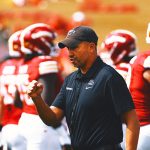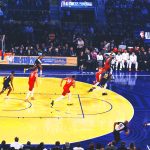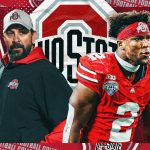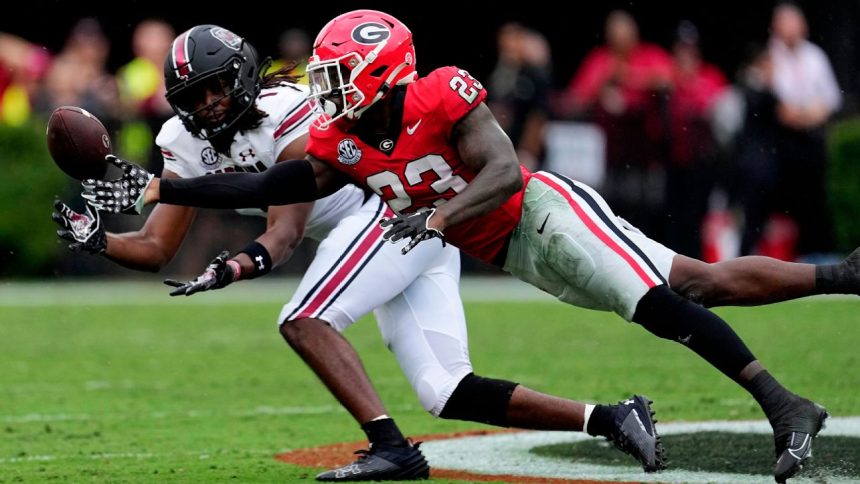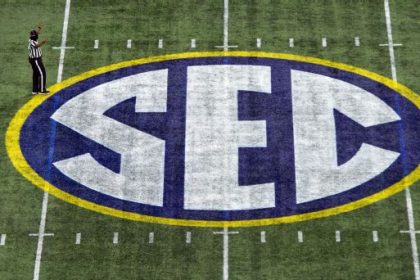
TAMPA, Fla. — With the NFL draft completed, and the Tampa Bay Buccaneers gearing up to hold a two-day rookie minicamp starting Friday, here’s a closer look at the Bucs’ draft class and how each player fits onto the roster.
Last year’s rookie class saw seven players earn a combined 61 starts between the regular season and two postseason games, and the expectations are equally as high for this year’s group.
First round
C Graham Barton, Pick No. 26
Coach Todd Bowles wanted “more beef” up the middle and to keep quarterback Baker Mayfield‘s uniform clean by reducing the amount of hits he takes — as 32 of the Bucs’ 54 sacks surrendered last year were attributed to the guard and center positions. Center Robert Hainsey, who gave up 11 sacks last year, stepped in for Ryan Jensen, but he has physical limitations, particularly with lack of lower body mass.
“We haven’t had the bulk in there since [Ali] Marpet [retired], obviously, and Ryan left and [Alex] Cappa left,” Bowles said. “Bringing size in there, getting a little bit over 300, 305 [pounds], getting a bigger guy, a taller guy, with some girth in there [and] trying to not let people go up the middle as much. I think it’ll help us that way.”
Barton, who is listed at 6-foot-5 and 314 pounds, is expected to start at center, with Hainsey competing there and also for the starting left guard position (assuming Cody Mauch stays at right guard). He plays with a strong base and anchor and a “nasty temperament,” as general manager Jason Licht put it, along with his ability to get off the ball and play with leverage.
“To me, it’s about making the right block, displacement and violence — that’s how the offensive line position should look, and I take a lot of pride in making sure I’m doing that to the best of my ability,” Barton said. “You can only play this game so long, so it’s like, why waste a snap? Every rep is foot on the gas. I think that’s kind of why I play with that nastiness and that violence, just because of the passion I have for the game, how much I love it and just how much I appreciate the opportunity to do this.”
Second round
OLB Chris Braswell, Pick 57
Unlike Yaya Diaby, a 2023 draftee who came in relatively inexperienced and had to rely more on his ability, Braswell has a lot of pass rush moves already in his arsenal. He also has experience dropping into coverage, which the Bucs ask of their outside linebackers. He had 10.5 tackles for a loss in his final year at Alabama, along with his eight sacks and three forced fumbles (he also had a pick-six against Mississippi State).
“He has a good toolbox coming in,” outside linebackers coach George Edwards said. “He’s a young man that when we looked at him on a tape, he displayed the skill set of everything we’re going to ask him to do. So we had a clear vision for what we were getting with him coming in and what we’re asking him to do wasn’t going to be foreign.”
The Bucs loved his competitive spirit when he came in for a visit, choosing to remain at Alabama despite playing behind Will Anderson Jr. and Dallas Turner and only starting two career games.
“When he came in here and visited with us, it was, ‘You ever think about leaving?’ ‘No, why would I leave? I picked Alabama. I love Alabama. I’m not afraid of competition. I believe in myself. This is where I want to be,'” assistant general manager John Spytek said. “He’s physical, he is trying to run through your face all the time, he’s gonna make you earn it every play. My experience in the league has been that those guys are tough to block, you get worn down after a while.”
Third round
DB Nickel Tykee Smith, Pick 89
The Bucs see Smith as a nickelback, with the expectation of competing for the starting job right away, but he’ll cross-train at safety too, where he had four interceptions and nine pass breakups in two years at West Virginia before transferring to Georgia. The playmaking, ball skills and physicality stand out most in assessing his tape. In 51 college games, he had eight interceptions, five sacks, 21.5 tackles for a loss and 140 tackles.
His four interceptions at Georgia were tied for third most in the SEC last year. He allowed 83 passing yards as the primary defender last season, with a 3.0 passing yards per attempt allowed — fourth in the SEC among defensive backs with 200 or more coverage snaps. He allowed a 39.3 completion percentage on 28 pass attempts last year — 10th best in the SEC — while his 19.1 raw QBR allowed as the primary defender was fifth in the SEC.
Spytek noted Smith’s mental acuity saying, “[He] is way ahead of a lot of kids that would enter the NFL, in a defense where we ask a lot of our secondary in particular. They have to know a lot of things, they have to be versatile, they have to think really fast — think on the fly. To me that’s always the biggest hurdle. These guys you pick on Day 1 and Day 2, they’re usually pretty good athletes — it’s the mental stuff that’ll slow ’em down.”
Last year’s starting nickelback, undrafted free agent Christian Izien, started and finished the year on a high note, but did have a midseason lull, something the coaching staff noted, but they’re still high on him. He allowed a 71.7 completion percentage last year — 26th among nickelbacks with 80 or more coverage snaps, according to NextGen Stats. Izien allowed 5.2 yards after the catch per reception last year, also 26th in the league. He’ll spend the spring training at safety, where Antoine Winfield Jr. and Jordan Whitehead are entrenched as starters, in addition to competing with Smith for the starting job at nickel.
WR Jalen McMillan, Pick 92
ESPN NFL draft analyst Mel Kiper Jr. called McMillian “a steal at the end of Round 3” and his “favorite prospect in Tampa Bay’s class” and he’s seen as a do-it-all receiver.
His 14 touchdowns over the past two seasons were 10th among Power 5 receivers. He was particularly effective on crossing routes, where his 26.67 yards per catch average was second most among Power 5 receivers over the past two years. Six of his touchdowns came on post routes over the past two years — tied for the most of any Power 5 receiver. In total, he produced a 62.9 first down or touchdown percentage — 13th in Power 5.
“On a team with two really good receivers — obviously one that went in the top 10 (Rome Odunze) and another one that went really early in the [second round, Ja’Lynn Polk], it was still really easy to see him,” Spytek said. “A lot of times, I think that guy can be forgotten about. But his athleticism, the way he naturally runs routes — like he plays like the game makes sense to him. Like there’s a smoothness and an easiness to his game that I think that you really appreciate. He makes some of things that I think are more challenging for the receiver position look fairly simple.”
With Chris Godwin moving back to the slot and the Bucs using more 11 personnel under new offensive coordinator Liam Coen, McMillan can step in as a true No. 3 receiver and possibly a future No. 2 with Godwin entering the last year of his contract.
Fourth round
RB Bucky Irving, Pick 125
The Bucs have had the league’s worst rushing attack over the past two seasons (82.9 yards per game). Some of that can be attributed to an offensive line that struggled with its interior run blocking and a scheme change last year. Rachaad White is still firmly entrenched as the starter. Still, the coaching staff would like to be able to spell White and give him a breather, and they couldn’t do that last year with Chase Edmonds out the first four regular-season games with an injury.
While Irving’s 4.55 40-yard dash time wasn’t particularly impressive (it was 14th among 20 running backs that tested at the scouting combine), his tape shows a real knack for evading defenders, breaking tackles and keeping his legs moving. He broke or evaded an FBS-high 144 tackles from 2022 to 2023. On top of that, he led all Power 5 running backs with 413 receiving yards on 56 receptions last year.
“We had him in on a visit, he told us that the first guy doesn’t tackle him,” Spytek said. “It’s no secret that Bucky isn’t — he’s not Christian Okoye, he’s not gonna run through people’s faces all the time. But you look at his production, whether it was at Minnesota or Oregon — he’s 6.0 yards a carry, he’s hard to get on the ground. And for a man that’s less than 200 pounds, when you do hit him, which is hard to do — he’s hard to knock off his feet.”
0:59
The highlights from newest Buccaneer Bucky Irving
Check out the highlights from the Buccaneers’ newest running back, Bucky Irving.
Sixth round
OG Elijah Klein, Pick 220
Klein will compete with Hainsey, as well as free agents Sua Opeta and Ben Bredeson for the starting left guard job, along with Mauch on the right side as an overwhelming majority of his snaps came at right guard (2,664) at UTEP with four coming at left guard. The Bucs have needed better interior run blocking and the Miners ran a run-heavy scheme with a lot of zone.
“I think run blocking is my specialty,” Klein said. “That’s what I like to do. I like to be the hammer — not the nail. I don’t like to be passive in any aspect of football so run game is something I really pride myself on.”
His 1.3% blown run block percentage was eighth best in Conference USA last year among guards with 500 or more snaps. In terms of pass blocking, while he may not have had the high number of reps some of his peers had because of the scheme he played in college, he gave up one sack in all of 2023. In his four seasons at UTEP, he allowed just four sacks — tied for sixth in the FBS among guards with 2,500 snaps or more and he allowed just 0.7% pressures in 2023 — second best among Conference USA and tied for 25th among all FBS guards last year.
“They’re getting a gritty, nasty dude,” Klein said when asked what Bucs fans can expect. “I don’t claim to be the lightest on my feet. I don’t claim to play with the most finesse. But what I do like to do is put my head down and hit people as hard as I can. So they’re expecting someone who’s grimy in the trenches.”
Seventh round
TE Devin Culp, Pick 246
Culp is the second Bucs tight end to come out of Washington in the past three years — they selected Cade Otton in the fourth round in 2022. He’s smaller than Otton at 6-3, 230 pounds, but he had a time of 4.47 seconds in the 40-yard dash, which is uncommon for a tight end and would make him the fastest of the Bucs’ current group.
“When you feel him in the run game, he feels like a bigger body,” Spytek said. “I think we were almost surprised when he weighed in at the combine that he was what he was because he strains to finish his blocks, he has strength through his core and in his feet and in his balance that allows him to stick on blocks — yeah he’s not gonna displace the bigger defensive ends in our league, but he stays attached to them and the pride that he has when he blocks jumps off the film to you. … You kind of expect that from bigger guys, but you don’t always expect that in games that are 230 or 240.”
He credits fellow UW grad and current Bucs outside linebacker Joe Tryon-Shoyinka for helping him develop his pass blocking skills. With the goal of Coen’s offense to get guys the ball in space, Culp’s selection makes sense. He said every day he’s been catching 100 balls per day, in addition to honing his footwork, striking on bags and improving his overall strength for the blocking.

